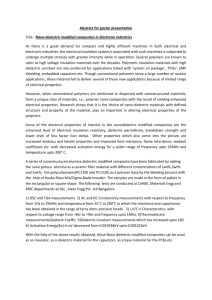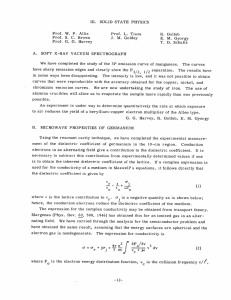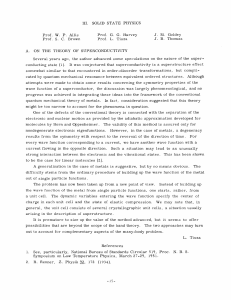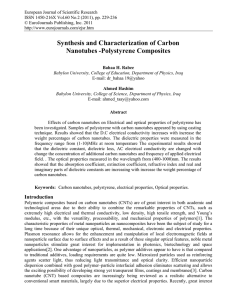The A.C Electrical Properties of (PVC-Sn) Composites
advertisement
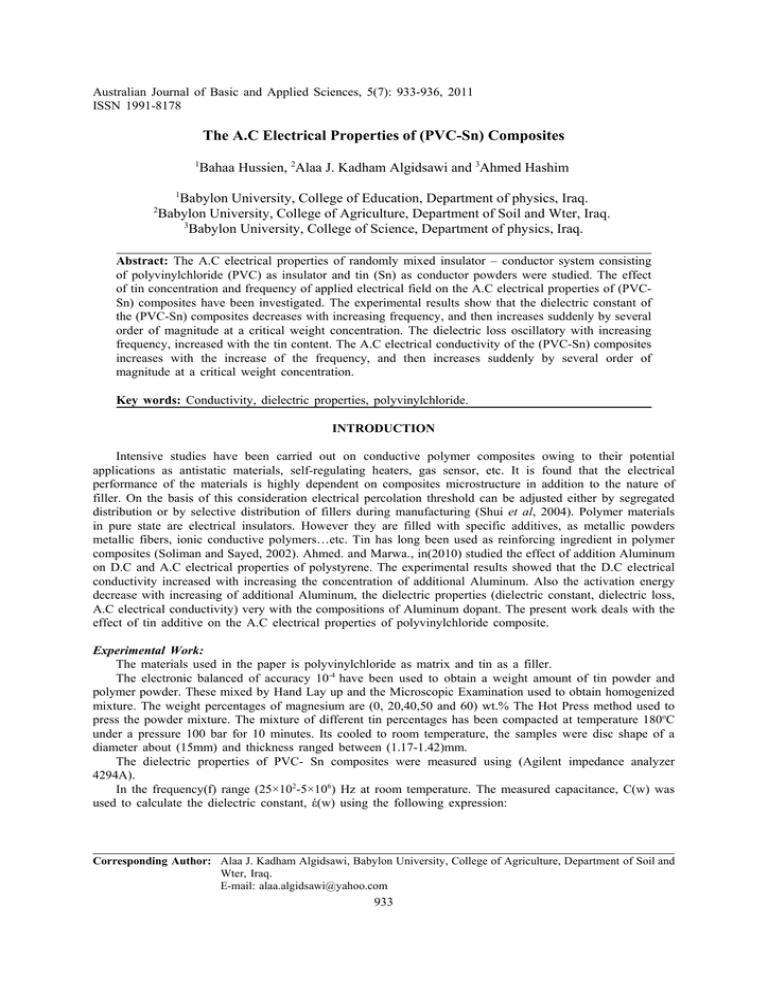
Australian Journal of Basic and Applied Sciences, 5(7): 933-936, 2011 ISSN 1991-8178 The A.C Electrical Properties of (PVC-Sn) Composites 1 Bahaa Hussien, 2Alaa J. Kadham Algidsawi and 3Ahmed Hashim 1 2 Babylon University, College of Education, Department of physics, Iraq. Babylon University, College of Agriculture, Department of Soil and Wter, Iraq. 3 Babylon University, College of Science, Department of physics, Iraq. Abstract: The A.C electrical properties of randomly mixed insulator – conductor system consisting of polyvinylchloride (PVC) as insulator and tin (Sn) as conductor powders were studied. The effect of tin concentration and frequency of applied electrical field on the A.C electrical properties of (PVCSn) composites have been investigated. The experimental results show that the dielectric constant of the (PVC-Sn) composites decreases with increasing frequency, and then increases suddenly by several order of magnitude at a critical weight concentration. The dielectric loss oscillatory with increasing frequency, increased with the tin content. The A.C electrical conductivity of the (PVC-Sn) composites increases with the increase of the frequency, and then increases suddenly by several order of magnitude at a critical weight concentration. Key words: Conductivity, dielectric properties, polyvinylchloride. INTRODUCTION Intensive studies have been carried out on conductive polymer composites owing to their potential applications as antistatic materials, self-regulating heaters, gas sensor, etc. It is found that the electrical performance of the materials is highly dependent on composites microstructure in addition to the nature of filler. On the basis of this consideration electrical percolation threshold can be adjusted either by segregated distribution or by selective distribution of fillers during manufacturing (Shui et al, 2004). Polymer materials in pure state are electrical insulators. However they are filled with specific additives, as metallic powders metallic fibers, ionic conductive polymers…etc. Tin has long been used as reinforcing ingredient in polymer composites (Soliman and Sayed, 2002). Ahmed. and Marwa., in(2010) studied the effect of addition Aluminum on D.C and A.C electrical properties of polystyrene. The experimental results showed that the D.C electrical conductivity increased with increasing the concentration of additional Aluminum. Also the activation energy decrease with increasing of additional Aluminum, the dielectric properties (dielectric constant, dielectric loss, A.C electrical conductivity) very with the compositions of Aluminum dopant. The present work deals with the effect of tin additive on the A.C electrical properties of polyvinylchloride composite. Experimental Work: The materials used in the paper is polyvinylchloride as matrix and tin as a filler. The electronic balanced of accuracy 10-4 have been used to obtain a weight amount of tin powder and polymer powder. These mixed by Hand Lay up and the Microscopic Examination used to obtain homogenized mixture. The weight percentages of magnesium are (0, 20,40,50 and 60) wt.% The Hot Press method used to press the powder mixture. The mixture of different tin percentages has been compacted at temperature 180oC under a pressure 100 bar for 10 minutes. Its cooled to room temperature, the samples were disc shape of a diameter about (15mm) and thickness ranged between (1.17-1.42)mm. The dielectric properties of PVC- Sn composites were measured using (Agilent impedance analyzer 4294A). In the frequency(f) range (25×102-5×106) Hz at room temperature. The measured capacitance, C(w) was used to calculate the dielectric constant, έ(w) using the following expression: Corresponding Author: Alaa J. Kadham Algidsawi, Babylon University, College of Agriculture, Department of Soil and Wter, Iraq. E-mail: alaa.algidsawi@yahoo.com 933 Aust. J. Basic & Appl. Sci., 5(7): 933-936, 2011 ( w) c( w) d o A (1) Where d is sample thickness and A is surface area of the sample. whereas for dielectric loss ε"(w): : ε"(w) ( w) ( w) tan ( w) (2) Where tanδ(w) is dissipation factor. The AC conductivity σac Can be calculated by the following equation: ac ( w) o w (3) RESULTS AND DISCUSSION The variations of dielectric constant of PVC-Sn composites as a function of frequency at room temperature of different filler concentrations is shown in figure(1). The dielectric constant is decreasing, characterizing of most dielectric material as reported in literature (Hussain and Zihlif, 1993). Fig. 1: Variation of dielectric constant with angular frequency for (PVC-Sn) composite. At low filler concentration(Φ<ΦC), the dielectric values are low, characteristics of dielectric behaviour, and increasing the filler concentration caused an increase in the average number contact among the conductive particles, which according gave an increase in dielectric constant values is shown in figure(2). Fig. 2: Variation of deilectric constant with Mg wt% concentration for (PVC-Sn) composite. The variation of dielectric loss as a function of frequency for PVC-Sn composites 0 for different filler concentrations at room temperature is shown in figure(3). The dielectric loss decreasing with frequency was attributed to interfacial polarization caused by heterogeneous of the system. The dielectric loss is increasing as a result of filler addition, which is attributed to the formation of conductive network by increasing the amount of filler conduct (Ahmed et al, 1993). 934 Aust. J. Basic & Appl. Sci., 5(7): 933-936, 2011 Fig. 3: Variation of dielectric loss with frequency for (PVC-Sn) composite. The behaviour of A.C conductivity of PVC-Sn composite for various concentration of the filler as a function of frequency at room temperature is show in figure (4). The A.C conductivity response to the applied field frequency at low and intermediate range is flat, and at high frequency range there is a transition region where the response starts to bent downward. The bending region is shifted towards the frequency value as the concentration of filler increases. For specimens of high filler content the behaviour of A.C conductivity can be determined by conductive pathways of conductive network which formed as a result of infinite clusters formation. Fig. 4: Variation of A.C electrical conductivity with Frequency for (PVC-Sn) composite. The flat response of A.C conductivity at these frequency ranges can be attributed to the fact that electrons will not have trouble traveling over large distances within these infinite clusters before it just hop to other clusters. This can be justified by the fact that most conductors give a flat response in the same frequency ranges [Vishnuvardhan et al,2006]. At lower concentrations of the filler(Φ<ΦC) the A.C electrical conductivity of the composite increases slightly; while at higher concentrations the conductivity increases sharply where the composite becomes a conductive substance. At high filler content(Φ>ΦC), the a mount of the interconnecting networks is increased and the contact resistance between the fibers is decreased, and hence a good electron conduction is achieved resulting in transformation of the polymer insulator to a conductive polymer composite[Shui. et al, 2004]. Conclusions: 1. The dielectric constant decreasing with the frequency and increase with Sn wt.% content. 2. The dielectric loss decreases with increasing the frequency for (Φ>Φc )and increasing with increasing the Sn wt.% content. 3. The dielectric loss is oscillatory with increase the frequency for (Φ<Φc) and increasing with increasing the Sn wt.% content. 4. The A.C electrical conductivity of PVC- Sn composites is increasing with increasing the frequency of applied electrical field and Sn wt.% content for (Φ<Φc). 5. The A.C electrical conductivity of PVC- Sn composites is decreasing with increasing the frequency of applied electrical field and Sn wt.% content for (Φ>Φc). REFERENCES Ahmed and Marwa, 2010. "The D.C and A.C Electrical Properties of Polymer Filled With Metal Powder", Proceedings of the First Scientific Conference of physics" /College of Education/ University of Babylon, November, Iraq. 935 Aust. J. Basic & Appl. Sci., 5(7): 933-936, 2011 Ahmed, S., Y. Rmadin, A. Jawd and M. Zihlif, 1993. J. Thermoplastic composite materials, B6, 108. Hussain A., Zihif M., 1993, Thermoplastic composite material, 6(120). Shui, G., J. Hu, M. Qiu, M. Wei and D. Xiao, 2004. J.Chinese Chem. Letters, 15(12): 1501-1504. Soliman and Sayed, 2002."Some physical properties of vinylpyridine carbon-black composites", J. Sol., 25(1). Vishnuvardhan T.K., V.R. Kulkarni, C. Basavaraja and S.C. Raghavendra, 2006, J.Bull. Mater. Sci., 29(1): 77-83. 936


